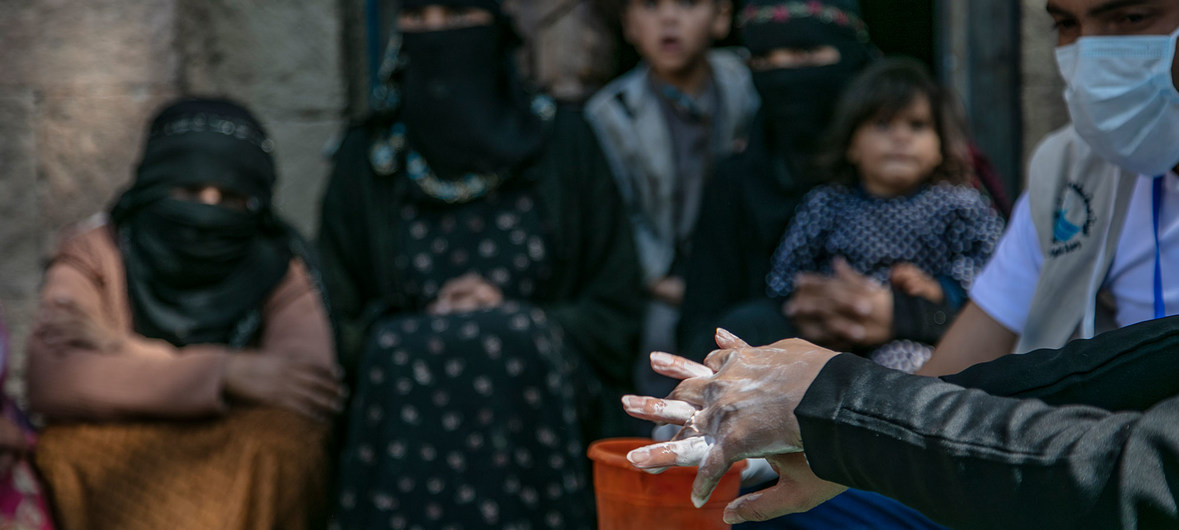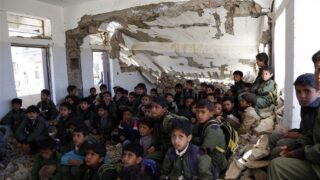Yemen was among the last countries to announce the arrival of the COVID-19 pandemic. The first confirmed case in the country was declared on April 10, 2020, a month after the World Health Organization declared a pandemic on March 11. An explosion of infections was anticipated in Yemen, where six years of war has destroyed the healthcare sector and fragmented the country. The first wave of COVID-19 in Yemen coincided with outbreaks of malaria, dengue fever, and chikungunya fever, diseases that have long been endemic in Yemen with symptoms similar to those of COVID-19.[1] At the time, Claire HaDuong, head of the Médecins Sans Frontières mission in Yemen, described the Yemeni response to the pandemic as a mixture of denial about the spread of the virus, and fear when faced with a case. Such panic was understandable given the country’s near-total lack of capacity to respond.[2]
Yemen has recorded one of the lowest COVID-19 infection rates and related deaths in the Middle East, although official counts by both the armed Houthi movement (Ansar Allah) and the internationally recognized Yemeni government are unreliable due to the lack of testing and access to medical treatment.[3] Moreover, Houthi authorities intimidated health workers, journalists, and even grave diggers to suppress information about the extent of the outbreak in areas they control.[4] Houthi authorities, which control most of the country’s large urban centers, have not provided statistics on the virus since May 2020 when they announced four cases of coronavirus and a single death.[5]
Covid-19 in Yemen: A Weaponless Battle
08-06-2021
Furthermore, fear and stigma associated with COVID-19 has prevented people from seeking medical care.[6] In Houthi-controlled areas, rumors circulated during the first wave that patients with suspected COVID-19 were being euthanized with so-called “mercy injections”. This fueled fear and discouraged people from going to hospital.[7] In addition, the poor reputation of hospitals pushed some people to stay home rather than seek treatment. During the first wave of the pandemic, the lack of response and prevention capacities prompted large numbers of health workers, at risk of being directly exposed to the virus, to resign and stay at home for fear of infection.[8] Many hospitals shut their doors to patients, including those not suffering COVID-19 symptoms, to limit spread among health workers.[9]
As the terror caused by the first wave subsided, so did people’s caution about the pandemic. A second wave of COVID-19 emerged in February 2021,[10] but according to Dr. Adam al-Juaidi, a doctor at the Shafak Center quarantine facility in Taiz, people became apathetic. Some believed that if they had contracted the virus they were then immune to it, and people were not prepared to stop working and lose their incomes as they had during the first wave, he said.[11]
While few have been spared the impact of this crisis, women and girls in Yemen have experienced the pandemic differently to men and boys. This policy brief explores the impact of COVID-19 on women in Yemen, surveying access to healthcare and how social norms create unequal access to treatment; the perceived rise in gender-based violence related to lost livelihoods and home confinement; and the economic impact of containment measures, like curfews and lockdowns, on Yemeni women.
1. Access to Healthcare
As in many societies, care work in Yemen is predominantly performed by women. Women are expected to care for children and husbands, and in some cases extended family members such as their husband’s sick or elderly parents, particularly in exceptional times like during epidemics and wars. Women, according to societal custom, are the designated household nurses. When sick themselves, women often do not seek medical attention except in critical cases; they are usually the last in a household to receive treatment.[12]
The practical difficulties associated with access to health facilities compounds this situation: a study conducted by Lancet Global Health in 2018 estimated that nearly 8.8 million of Yemen’s total population – roughly one-third – live more than 30 minutes from the nearest fully or partially functioning public primary healthcare facility, and that more than 12 million Yemenis live more than an hour from a public hospital. Nearly 40 percent of Yemenis live two hours away from facilities providing obstetric care and comprehensive emergency surgery.[13] These estimates assume that people have access to transport, which itself has been severely affected by the war. Roads are no longer safe and are often unsuitable for travel due to damage or the effects of floods, while travel costs may be prohibitive because of the sharp rise in the price of fuel.
What “Precautions” in a Country like Yemen?
02-08-2021
Women may be delayed in, or prevented from, receiving healthcare treatment for various reasons. According to interviews conducted between May 2o2o and March 2021 with a number of healthcare and civil society workers that had direct contact with the situation of the pandemic on the ground in Taiz, Aden, Hadramawt, Shabwa, Hudaydah and Lahj, financial struggles were a key obstacle preventing access to healthcare. COVID-19 has negatively impacted the livelihoods of people across the world; in Yemen, where the population was already suffering from conflict and economic crisis, the pandemic has exacerbated widespread poverty, limiting access to often costly healthcare. According to Sami al-Hakimi, who works for the international organization CARE in Taiz city, due to poverty women often only go to hospital in critical cases, while men and children are usually prioritized for healthcare. Alia al-Hamdi, of the Yemeni Women’s Association in Hadramawt, said healthcare standards for women were deficient under normal circumstances, a situation that has been compounded during the COVID-19 pandemic. For many women, even medical services in government hospitals are unaffordable.[14]
While financial obstacles are a key factor in women’s lack of access to healthcare, social norms also play a key role. Yemeni society is characterized by strict social norms that restrict women’s behavior in large parts of the country. For example, some families require that female relatives are treated in the presence of a female doctor, limiting women’s access to treatment. The resignation and/or absence of many health workers during the pandemic made it harder to ensure the presence of female doctors. Furthermore, quarantines in the event of illness, and remaining in isolation for extended periods, are both wholly unfamiliar in Yemeni society. For some Yemeni women and men, the prospect of isolation may be more disagreeable than the disease, while Yemeni women may be unwilling or unable to leave their domestic work and child care. According to Yemeni social norms, Yemeni women are expected to spend most of their time at home. Recognizing this, the Houthi authorities in Sana’a ordered that men in the city would be quarantined in the Movenpick Hotel while women should quarantine at home.[15]
Dalia al-Dhabhani, from Hudaydah Girls Foundation, said women’s domestic healthcare duties meant they bore a heavy burden from the pandemic: As well as risking infection themselves, they have also suffered exhaustion and delays in obtaining healthcare. In some cases women were blamed for deaths in their families and accused of not caring for the patient adequately, according to Manal al-Shaibani, who participated in an initiative to relieve patients using oxygen tanks at the height of the outbreak in Aden. She recalled that a young doctor was ostracized at her mother’s funeral by mourners who blamed her for not providing sufficient treatment. Al-Shaibani’s initiative has provided psychological support to grieving families of COVID-19 victims and to young women who experienced anxiety from their suffocating confinement. All are victims of government neglect and a failing health system, Al-Shaibani said. She and her team faced many sudden deaths which they were not equipped to handle, causing a profound psychological impact. Due to this trauma, she and others made the decision not to participate in initiatives during the second wave, she said.
Hanan Saleh al-Badawi heads the Basma Development Foundation in Lahj and helped establish a medical initiative to help people affected by the pandemic. She said she focused her efforts on women, for example by purchasing and delivering medicine to women in their homes, and by bringing female doctors to the homes of women who were unable to go to hospital. Al-Badawi noted the huge differences in the status of men and women with regard to family care, where caring responsibilities rest with the woman even if she is sick herself.
Some interviewees also pointed to the bad reputation of the health sector as a factor deterring women from seeking healthcare. Even before the war, health services in Yemen were inadequate. At the start of the pandemic, the closure of many hospitals and clinics meant treatment was restricted to small, underequipped centers. By May 2020, there were only around 37 quarantine centers, 208 respirators and four laboratories for testing in Yemen.[16] News circulated about patients dying in hospital corridors after doctors refused to receive or examine them due to widespread fears of infection. Poor management by the authorities meant practical measures to provide testing and prevention tools were not provided. People died in their homes, in the streets and in cars while seeking medical care in hospitals which refused to admit them. Fear of infection also deterred patients from seeking medical care for conditions unrelated to COVID-19. Zaha al-Aidarus, an intensive care doctor in the Amal Quarantine Center, said people stopped seeking medical care in Al-Jumhuriyah Hospital, one of the largest in Aden, because the presence of a quarantine center marred the hospital’s reputation, as did its poor treatment of patients.
Generally, far fewer women have used quarantine centers. Dr. Adam al-Jaidi from the Shafak Medical and Quarantine Center in Taiz said women constituted less than 10 percent of all arrivals at the center, noting that women were the least able to access healthcare of any kind. On the other hand, Dr. Nashwan al-Hussami, director of al-Jumhuriyah Hospital in Taiz, said women did not exceed 5 percent of all patients, adding that women were the least likely to receive healthcare whether due to social norms or economic conditions. Looking ahead, he said women whose families lost their breadwinners would face increased psychological stress. In addition, support to the quarantine center to deal with COVID-19 had stopped, while the currency’s devaluation affected the operational capacity of the center as well as people’s ability to buy medicine.[17]
The reduction of support from international donors to Yemen’s humanitarian response has diminished financial support for the medical sector, while the COVID-19 pandemic affected all those in need of healthcare, not just those infected with the virus. The dual impact of cuts in funding to Yemen and the COVID-19 pandemic could have dire consequences for maternal health. Research from Sierra Leone between 2013 and 2016, during the Ebola epidemic, showed that more women died due to obstetric complications than from Ebola.[18] In Yemen, after the first wave of cuts that followed the international donor conference in June 2020, maternity services in 150 UN-supported hospitals were closed.[19] Dr. Ahed Lakhdar, a gynecologist and obstetrician from Shabwa, said that during the first weeks of the pandemic, private medical centers that provide maternity services were closed for two weeks, forcing women to use government hospitals, many of which have poor reputations. Dr. Al-Hussami, from Al-Jumhuriyah Hospital in Taiz, said the number of women accessing maternal healthcare did not decrease during the pandemic.
The outlook for maternal healthcare in Yemen is bleak: A 2020 appeal from the UN Population Fund for urgent support for its program in Yemen warned that more than 48,000 women could die from complications of pregnancy and childbirth due to severe funding shortages and the possible closure of reproductive healthcare facilities.[20]
2. Gender-Based Violence
Historically, public health crises have exacerbated domestic and gender-based violence. In the Ebola outbreak between 2014-2016, and the Zika virus outbreak of 2015-2016, quarantine conditions or stay-at-home measures placed many women and children who lived with violent men at much greater risk.[21]
A surge in domestic violence has been witnessed on a global level during the COVID-19 pandemic. The UN reported that calls to domestic violence helplines doubled in Lebanon and Malaysia and tripled in China during the pandemic, while online searches for domestic violence reached the highest level in five years in Australia.[22] In countries such as Cyprus and Singapore, helplines recorded an increase in calls of 30 percent and 33 percent, respectively, and in Argentina, there was a 25 percent increase in emergency calls regarding domestic violence cases.[23] Activists, civil society organizations and government authorities in Canada, Germany, Spain, the United Kingdom and the United States said reports of domestic abuse increased during the COVID-19 pandemic while France reported a 30 percent rise in domestic violence cases after lockdown measures were put in place in March 2020. In Australia, a survey on women’s safety in New South Wales revealed a rise in calls for help, with 70 percent of frontline workers reporting that cases had become more complex during the pandemic.[24]
According to the Organisation for Economic Co-operation and Development, official figures suggest around 35 percent of married women in the Middle East and North Africa have experienced intimate partner violence, close to the global average of 33 percent.[25] In Yemen, the UN says gender-based violence increased by 63 percent during the current war, and since 2017, approximately 17 percent of women and girls have been at high risk of gender-based violence.[26]
While data is not available to track gender-based violence in Yemen during the pandemic, several experts reported that incidence of violence against women has risen. Alia al-Hamidi, from the Yemen Women’s Union in Hadramawt, said their center received multiple cases of gender-based violence cases during the first wave of the pandemic, including verbal and physical abuse. The main cause of domestic problems was men’s failure to provide financially for their wives and children, Al-Hamadi said. Sawsan al-Shaddadi, program officer at the Yemeni Women’s Union in Aden, also reported a rise in domestic violence, which she said was directly linked to men losing their jobs. Likewise, Al-Hakimi, the CARE staffer in Taiz, said that male breadwinners’ loss of livelihoods contributed to a rise in domestic violence. Male unemployment is widely perceived as a driver of domestic violence in Yemen, in part because it undermines men’s sense of masculinity and also because financial insecurity can lead to quarrels between spouses.[27]
Al-Shaibani said women’s loss of employment also contributed to an increased risk of domestic violence during the pandemic. For some women, their work had provided an escape from exposure to violence at home, while their income had also protected them from domestic abuse. Staying at home is a struggle in Aden’s hot climate, with irregular electricity, Al-Shaibani noted. Social norms obliged women to spend their time at home, while male family members were freer to spend time outside the house. Al-Shaibani pointed out that many women in Aden, especially the elderly, became ill after being infected by their sons who flouted lockdown measures, for example by continuing to visit the qat market.
3. Economic Impact
Public health measures imposed during the pandemic, such as quarantines, lockdowns and stay-at-home orders, have disrupted people’s livelihoods globally. Such disruptions affect women and men differently. For example, restrictions imposed during the Ebola epidemic in 2014-2016 significantly diminished economic activities, leading to a rise in poverty rates and food insecurity. While men generally resumed work once restrictions were eased, the negative impact on livelihoods was longer-lasting for women.[28]
Early research on the COVID-19 pandemic’s impact on women suggests that jobs performed by women are 19 percent more at risk than those performed by men. While women make up 39 percent of the international workforce, they are disproportionately represented in three of the four most declining industries globally: accommodation and food services (54 percent); retail and wholesale trade (43 percent); and services such as arts, recreation and public administration (46 percent).[29]
It is estimated that the COVID-19 pandemic will result in 1.7 million job losses across the Arab region, including approximately 700,000 jobs held by women. Women’s participation in the labor market is low in the region, and female unemployment reached 19 percent in 2019, compared to 8 percent among men.[30] In Yemen, women make up a small proportion of the labor market, but they were severely affected during the pandemic.
Restrictions related to COVID-19 threaten the fragile economic gains achieved by some women in Yemen in recent years. The war and the conflict-driven economic crisis have increased the number of female-headed households and pushed Yemeni women into the paid workforce, starting home-based businesses and entering nontraditional sectors.[31] Al-Dhabhani said the pandemic had undermined this work. For example, women selling school supplies and meals to students were left without work by school closures. Many women work in occupations that were suspended during lockdown, such as: selling home-made food or other commodities on the streets, door-to-door, or in schools; working in beauty salons; wedding-related occupations such as photographers and wedding hall staff; and in schools whether as teachers, janitorial or service staff. During the war, some women started their own businesses like cafes or restaurants for women; these were among the first to close during the pandemic.
Al-Shaibani said the economic damage suffered by women has been significant; she lost her job as a director working in the arts and theater due to the pandemic, and has turned to volunteering initiatives. Many other women lost work in handicrafts or selling home-cooked food, she said. Al-Hamdi, from the Yemeni Women’s Association in Hadramawt, said many women lost their jobs in private offices and institutions because employers could no longer afford their salaries. Women selling fruit and vegetables, and incense and perfume were affected by the closures of markets. These job losses, alongside the rising price of basic goods, including food, created a difficult situation for women and their families.
The decline in family income during the pandemic presents multiple risks to women and girls. As discussed above, the financial insecurity and unemployment stemming from the wartime economic crisis in Yemen has been linked to a rise in gender-based violence in the home and in public spaces. It has also been linked to a decrease in the enrollment of children to school, especially girls. Rising pandemic-related healthcare needs may also keep girls away from school. This was experienced during the Ebola epidemic in West Africa, when girls whose mothers contracted the disease had to stay home from school to care for them.[32] Financial strain is also a factor in early marriage. Such marriages are already prevalent in the MENA region, but the rising economic burden may increase the likelihood of families accepting early marriage for their daughters.[33]
Looking Ahead
This report has signposted ways in which women and girls in Yemen may have experienced the COVID-19 pandemic differently.
The following are principles to guide efforts by the international community, donors, and Yemeni authorities to mitigate the impact of the COVID-19 pandemic in Yemen:
Immediate priorities:
It is critical to speed up the provision of vaccines to Yemen. So far, Yemen has only received 360,000 doses of the vaccine and fewer than 300,000 Yemenis have received a single dose.
Outreach and advocacy should be conducted to communicate the dangers of COVID-19 as well as the importance of women receiving medical treatment when necessary. Such information can be disseminated via local radio stations and also in mosques to ensure a swift and wide reach.
All medical facilities should be provided with necessary protective equipment to deal with infectious diseases, as well as other necessary medical supplies, including those needed for women’s health.
Medium-term priorities:
More clinics and hospitals should be established, particularly outside cities. Women in remote areas lack access to healthcare, due to the lack of medical facilities and also because poor roads and high transportation costs limit mobility.
More shelters should be established for women experiencing domestic violence, particularly in stable areas beyond conflict zones. These should provide psychological, health, and material assistance to the abused women, and may encourage more reporting of gender-based violence.
More funding should be directed to support microfinance initiatives to assist women who lost their jobs or businesses during the pandemic.
This article was produced as part of the Yemen Peace Forum, a Sana’a Center initiative that seeks to empower the next generation of Yemeni youth and civil society activists to engage in critical national issues.
The Sana’a Center for Strategic Studies is an independent think-tank that seeks to foster change through knowledge production with a focus on Yemen and the surrounding region. The Center’s publications and programs, offered in both Arabic and English, cover diplomatic, political, social, economic and security-related developments, aiming to impact policy locally, regionally, and internationally.
1-“Catastrophe unfolding in Aden’s COVID-19 treatment centre,” Médecins Sans Frontières, May 21, 2020,
https://www.msf.org/aden’s-only-covid-19-treatment-centre-we-are-seeing-catastrophe-unfold
2-“‘COVID-19 has made the health system’s collapse complete’ in Yemen”, [AR], MSF, June 10, 2020,
https://bit.ly/2Po8UuL
3-Joseph Hincks, “Yemen Officially Has One of the Middle East’s Lowest COVID-19 Counts. In Reality, the Virus Is Spreading Unseen and Unchecked”, Time, May 28, 2020,
https://time.com/5843732/yemen-covid19-invisible-crisis/
4-Maggie Michael, “Hundreds die in Yemen of suspected coronavirus outbreak”, Associated Press, May 15, 2020,
https://apnews.com/article/0fa08ac04778a3d8a37579fb97a63572
5-“Yemen warns against possible second coronavirus wave”, Reuters, February 24, 2021,
https://www.reuters.com/article/us-health-coronavirus-yemen-idUSKBN2AO1UO
6-“As COVID-19 spreads, fear drives people away from hospitals in Yemen”, MSF, July 9, 2020,
https://www.msf.org/covid-19-spreads-fear-drives-people-away-hospitals-yemen
7-Maggie Michael, “Yemen’s rebels crack down as COVID-19 and rumors spread”, Associated Press, June 9, 2020,
8-“As COVID-19 spreads, fear drives people away from hospitals in Yemen”, [AR], MSF, July 9, 2020,
https://bit.ly/31guLXC
9-“Yemen: ‘White Army’ in an Unequal Battle with the Coronavirus”, [AR], Al-Mushahid, June 8, 2020,
https://almushahid.net/61070
10-“Yemen warns against possible second coronavirus wave”, [AR], Reuters, [February 24, 2021], https://reut.rs/39cFsPr
https://www.reuters.com/article/health-coronavirus-yemen-as5-idARAKBN2AO0KS
11-Dr. Adam al-Juaidi, [personal] interview [by the author], [Taiz], [Yemen], March 2021.
12-Alia al-Hamidi, [personal] interview by the author], [Hadramawt], [Yemen].
13-Kent Garber, Charles Fox, Moustafa Abdalla, Andrew Tatem, Naseeb Qirbi, Laura Lloyd-Braff, Kahtan Al-Shabi, Kennedy Ongwae, Meredith Dyson, Kebir Hassen, “Estimating access to health care in Yemen, a complex humanitarian emergency setting: a descriptive applied geospatial analysis”, The Lancet, Vol 10, November, 2020,
https://www.thelancet.com/action/showPdf?pii=S2214-109X(20)30359-4
14-“As the Coronavirus Pandemic Spreads, Who is Confiscating Respirators from the Medicine Market in Sanaa?”, [AR], Al-Mushahid, June 10, 2020,
https://almushahid.net/61140
15-Author’s confidential interview with a doctor at Al-Thawra Hospital, May 2020.
16-Naomi Grimley, “Coronavirus: Yemen holds its breath in anticipation of an ‘unspeakable’ crisis”, [AR], May 3, 2020,
https://www.bbc.com/arabic/middleeast-52518240
17-Dr. Nashwan al-Hussami, [personal interview by the author], [Taiz], [Yemen], March 2021.
18-Helen Lewis, “The Coronavirus Is a Disaster for Feminism”, The Atlantic, March 19, 2020,
https://www.theatlantic.com/international/archive/2020/03/feminism-womens-rights-coronavirus-covid19/608302/
19-Sam Kiley, “Experts fear Yemen could suffer one of the world’s worst coronavirus outbreaks”, CNN, June 5, 2020,
https://edition.cnn.com/2020/06/04/middleeast/yemen-coronavirus-intl/index.html
20-“Urgent funding needed to protect health and safety of women and girls in Yemen amidst COVID-19”, [AR], UNFPA, May 6, 2020,
https://reliefweb.int/sites/reliefweb.int/files/resources/Arabic%20-%20UNFPA%20Funding%20Shortage%20in%20Yemen%20-%20Press%20release.pdf
21-“What the COVID-19 pandemic tells us about gender equality”, World Economic Forum, May 9, 2020,
https://www.weforum.org/agenda/2020/05/what-the-covid-19-pandemic-tells-us-about-gender-equality/
22-“UN chief calls for domestic violence ‘ceasefire’ amid ‘horrifying global surge’”, April 6, 2020, UN News,
https://news.un.org/en/story/2020/04/1061052
23-“COVID-19 and Ending Violence Against Women and Girls”, UN Women, June 30, 2020,
https://www.unwomen.org/-/media/headquarters/attachments/sections/library/publications/2020/issue-brief-covid-19-and-ending-violence-against-women-and-girls-en.pdf?la=en&vs=5006
24-“COVID-19 and Ending Violence Against Women and Girls”, UN Women, June 30, 2020,
https://www.unwomen.org/-/media/headquarters/attachments/sections/library/publications/2020/issue-brief-covid-19-and-ending-violence-against-women-and-girls-en.pdf?la=en&vs=5006
25-“COVID-19 crisis in the MENA region: impact on gender equality and policy responses”, Organisation for Economic Co-operation and Development, June 10, 2020,
https://read.oecd-ilibrary.org/view/?ref=134_134470-w95kmv8khl&title=COVID-19-crisis-in-the-MENA-region-impact-on-gender-equality-and-policy-responses
26-Margaret Habib, “COVID-19 exacerbates the effects of water shortages on women in Yemen”, Relief Web, August 20, 2020,
https://reliefweb.int/report/yemen/covid-19-exacerbates-effects-water-shortages-women-yemen#:~:text=In%20Yemen,%20GBV%20has%20increased,based%20violence%20around%20the%20world
27-Fawziah Al-Ammar, Hannah Patchett & Shams Shamsan, “A Gendered Crisis: Understanding the Experiences of Yemen’s War,” Sana’a Center For Strategic Studies, December 15, 2019,
https://sanaacenter.org/publications/main-publications/8480
28-UN Secretary-General, “Policy Brief: The Impact of COVID-19 on Women”, UN, April 9, 2020,
https://www.unwomen.org/-/media/headquarters/attachments/sections/library/publications/2020/policy-brief-the-impact-of-covid-19-on-women-en.pdf?la=en&vs=5029
29-Johnny Wood, “COVID-19 has worsened gender inequality”, World Economic Forum, September 4, 2020,
https://www.weforum.org/agenda/2020/09/covid-19-gender-inequality-jobs-economy/
30-“The impact of COVID-19 on Gender Equality in the Arab Region”, UN Economic and Social Commission for Western Asia, April 6, 2020,
https://reliefweb.int/sites/reliefweb.int/files/resources/policy_brief_on_the_impact_of_covid-19_on_gender_relations_in_the_arab_region_en_1.pdf
31-Fawziah Al-Ammar, Hannah Patchett & Shams Shamsan, “A Gendered Crisis: Understanding the Experiences of Yemen’s War,” Sana’a Center For Strategic Studies, December 15, 2019,
https://sanaacenter.org/publications/main-publications/8480
32-“COVID-19 crisis in the MENA region: impact on gender equality and policy responses,” OECD, 10 June 2020,
https://read.oecd-ilibrary.org/view/?ref=134_134470-w95kmv8khl&title=COVID-19-crisis-in-the-MENA-region-impact-on-gender-equality-and-policy-responses
33-Hafsa Halawa, “The gendered impact of COVID-19 in the Middle East”, MEI@75, June 11, 2020,
https://www.mei.edu/publications/gendered-impact-covid-19-middle-east
Tags: COVID-19 women







